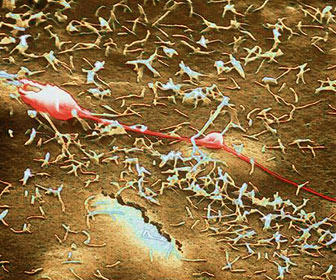Mycoplasma pneumoniae taxonomy, morphology and culture
Mycoplasma and ureaplasma belong to the class Mollicutes with a total of about 200 species, are summarized in the bacterial cell wall. For human infections the genera Mycoplasma (M. pneumoniae, M.genitalium, M.hominis, M.fermentans) and Ureaplasma are (U.urealyticum, U.parvum) Mycoplasmataceae the family of clinical importance. Mycoplasma can be grown in special culture media.
Pathogenesis, epidemiology, and selected diseases

Mycoplasmas have a strict host and tissue specificity (mucosal cells of various organs) through an accumulation of cells via specific adhesins. Variations on antigen the immune system of the host is turned off, obviously can persist and intracellularly mycoplasma.
Mycoplasma pneumoniae is the cause of community-acquired pneumonia and bronchitis in Germany after CAPNETZ data with 6.8% of patients. The pathogen occurs mainly in the colder months, mainly in children and in adults under 60 years. The course is usually relatively easy, but are possible complications of central nervous way as encephalitis, aseptic meningitis, myelitis and polyradiculoneuropathy.
M.genitalium is at a urethritis of the man, that is not caused by Neisseria gonorrhoeae, one of the most important pathogens. M.genitalium is sexually transmitted. In women M.hominis or M.genitalium with cervicitis, endometritis, salpingitis, tubo-ovarian abscesses or inflammation in the pelvis are demonstrated. The etiological role of M.genitalium with complications in pregnancy is currently unclear. M.hominis In rare cases can cause meningitis in newborns.
U.parvum, U.urealyticum: In men ureaplasma can cause urethritis, prostatitis or epididymitis. Ureaplasma are found in women without clinical symptoms in up to 70% as commensals in the vagina. In the context of bacterial vaginosis and inflammation of the upper genital tract of women they are detected together with other bacterial species. There may be a correlation between the presence of U.urealyticum and infertility, Dead or prematurity, chorioamnionitis and perinatal death. There is a correlation between the neonatal detection of ureaplasma and pneumonia and bronchopulmonary dysplasia. For heavily underweight newborns is also reported CNS infections with intraventricular hemorrhage. U.parvum populated with women outside of pregnancy up to 57% of the vagina, but can also be an inflammatory reaction to premature rupture of membranes, preterm labor, chorioamnionitis and the child lead to sepsis and meningitis, as well as bronchopulmonary dysplasia.
Therapy, mandatory reporting
The treatment of infections caused by M. pneumoniae is done with macrolides such as azithromycin (ZITHROMAX others), doxycycline (DOXYHEXAL etc.) or fluoroquinolones [moxifloxacin (Avelox . etc.)], where it is important to note that since some strains are resistant to macrolides. Visit at www.ndrugs.com for medications. In infections by M.genitalium are azithromycin (duration over five days; resistant strains can occur), or moxifloxacin therapy of doxycycline effective. infections with moxifloxacin M.hominis or clindamycin (CLINDAMYCIN-ratiopharm, etc.). ureaplasma are sensitive to moxifloxacin and doxycycline.
| Name | Dosage | |
| Tetracycline | 250 - 500 mgs | 4 times a day for 5-7 days |
| Levofloxacin | 250 - 750 mgs | once a day |
| Clarithromycin | 250 - 500 mgs | twice a day |
| Moxifloxacin | 400 mgs | once a day intravenously |
| HIV diagnostics | | |
| Josamycin | 1 g | once or twice a day between a meal |
| Erythromycin | 250 - 500 mgs | 4 times a day at least 2 hours before a meal |
| Azithromycin | 250 - 500 mgs | once a day at least 1 hour before or 2 hours following a meal |
| Midecamycin | 400 mgs | 3 times a day before a meal for 14 days |
| Roxithromycin | 300 mgs | once or twice a day |
| Fusafungine | 4 inhalation in the mouth and / or in each nostril | every 4 hours for not more than 10 days |
| Spiramycin | 2–3 million IU | 2-3 times a day (increased to 15 million units/day, given in divided doses for severe infections) |
| Sparfloxacin | 400 mgs at first day, 200 mgs at other days | once a day at morning |
| Grepafloxacin | 400 - 600 mgs | once a day for 7 - 10 days |
| Doxycycline | 200 mgs at first day, 100 mgs at other days | 5 - 10 days |
| Oleandomycin | 250 - 500 mgs (2 g - Max in a day) | 4-6 times a day following a meal for 5 - 7 days |
| Lincomycin | 500 mgs (max - 1,5-2 gramm a day) | 3 times a day for at least 10 days |
| Lomefloxacin | 400 mgs (up to 600-800 mgs) | twice a day for 10 - 14 days |
|
Mycoplasma pneumoniae diagnosis
Mycoplasma pneumoniae infections can by means of antibody detection (ELISA, paired samples) are identified, and cross-reactions with M.genitalium exist. A culture in special media is possible. The bacteria can be detected by PCR; a multiplex PCR for the detection of all major species in urogenital infections was recently described.
|